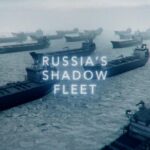Energy News Beat
ENB Pub Note: Michael and I have talked about the “Shadow Fleet” for several years. Iran had been ahead of Russia in avoiding sanctions, but both have successfully made the United States irrelevant after the current administration’s weaponization of the US dollar around the world.
A “shadow fleet” of aging tankers is keeping Russian oil flowing. Bloomberg set out to uncover the network of intermediaries working to sell the Kremlin’s oil while getting rich in the process. (Source: Bloomberg)
Shadow or Dark Fleet of Ships Acquired by somebody unknown – and insured by who knows? – If there is an accident – there would be no one to be held liable – The two countries that are buying outside.
Politico: Ever since Russia invaded Ukraine, a steady stream of such rickety vessels without insurance protection have been joining the dark fleet (as the vessels are also known) — and many of them have been having accidents. This situation poses enormous risks to law-abiding ships, the environment and the unfortunate countries controlling the waters in which these accidents occur.
Because Western sanctions have banned trading a wide range of Russian goods and put a cap on the price of Russian oil, Western insurers — who dominate the market — no longer insure such shipments. Thus, companies that still want to engage in this lucrative trade have been turning to shadow vessels instead — ageing ships with obscure ownership that lack international certification and Western insurance.
“The little piece of paper a dark ship may have that says it’s insured is not worth the paper it’s written on,” said Simon Lockwood, a maritime executive with the insurance broker WTW.
Two-thirds of the tankers carrying Russian crude are now insured by “unknown.” And because they lack proper insurance and disguise their ownership, these tankers also operate outside international maritime regulations.
And this shadow fleet is growing fast: Today it encompasses some 400-650 vessels — already several times its size before Russia’s invasion of Ukraine — and two-thirds are estimated to be oil tankers.
According to S&P Global, in Gabon — today’s flag state of choice for the growing dark fleet — a whopping 98 percent of all medium and large oil tankers are high risk or have no identifiable owner. And Norwegian authorities estimate that an average of 12 shadow vessels, typically transporting Russian oil, traverse Norwegian waters every day.
“The very tools that the shadow fleet avoid using to avoid detection are the tools specifically implemented to prevent accidents at sea,” a maritime analyst with Control Risks said | Ulet Ifansasti/Getty Images)
Unsurprisingly, the number of dark-fleet accidents has been growing as well. Vessels have caught fire, run aground, caused oil spills, lost steerage and collided with other vessels. My research assistant, Katherine Camberg, has identified nearly three dozen incidents involving suspected dark ships over the past 18 months alone. The accidents aren’t just a result of these vessels being old and poorly maintained either: To be as dark as possible, they often turn off their automatic identification systems (AIS) — a GPS-type signal that all commercial vessels are required to use to avoid collisions.
“The very tools that the shadow fleet avoid using to avoid detection are the tools specifically implemented to prevent accidents at sea,” said Cormac Mc Garry, a maritime analyst with Control Risks. “By switching off AIS, a ship is increasing the risk of collision. The shadow fleet is setting us back years in terms of maritime safety management.”
The post Russia’s Shadow Fleet – 24 min Bloomberg Video – “Ships aquired by “We don’t know who; and insured by who knows?” appeared first on Energy News Beat.








